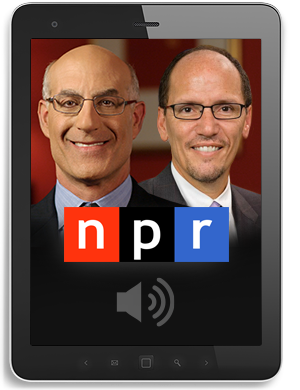Do-It-Yourself Portfolio Management
Many of us woke up New Year’s Day wondering where the heck our investment portfolios had gone, and why, once again, we had failed to learn the lesson of prior market crashes: Even the smart money sometimes is dumb, including the pros to whom we entrust our money.
If the past year’s returns are as good as Wall Street’s best and brightest can do, you might as well do it yourself, says Mitchell Tuchman, CEO of MarketRiders, a new investment-advisory service for D-I-Y investors. At the very least, spreading your dough across the right mix of “passive” exchange-traded funds, says Tuchman, will save you the return-killing fees and taxes that come from investing with active fund managers.
We small fry trust money managers in the first place because we lack the time, expertise, confidence and computer models to build properly diversified portfolios ourselves. That’s what MarketRiders E.Adviser provides, as do similar services from discount brokers E*Trade and TD Ameritrade. They crunch the numbers and make asset-allocation recommendations for a nominal fee.
Loosely grounded in Modern Portfolio Theory, with its emphasis on minimizing risk through diversification, these services follow in the footsteps of Financial Engines, which pioneered MPT portfolio-building for retail investors in 1998. Financial Engines now offers optimal portfolio allocations for a million investors, mostly through 401(k) plans. Non-plan investors can use the services for about $150 a year.
MarketRiders E.Adviser costs $100 annually and, unlike Financial Engines, recommends exchange-traded funds exclusively. Building a portfolio with E.Advisor takes just minutes. You answer a few questions about your risk tolerance and investment horizon, and E.Advisor suggests an asset allocation. Alternatively, you can use a ready-made portfolio template and add your current holdings.
Portfolios of $100,000 or more offer the best balance between diversification and cost reduction. Select a brief seven-year time horizon (to increase difficulty) and medium risk tolerance, and E.Advisor suggests its Moderate Risk- Bonds Portfolio with an allocation of 41% bonds, 25% U.S. equities, 11.5% developed- country equities, 9% inflation-protected bonds, 8% real estate and 5.5% emerging markets. Funds are spread across 15 ETFs culled from a list of 800 funds MarketRiders has pre-screened to maximize liquidity and minimize cost.
Again, to reduce costs, MarketRiders recommends using a discount broker such as E*Trade or TD Ameritrade to execute trades. All trades are reported to E.Adviser, which tracks your portfolio’s progress and alerts you by e-mail when it’s time to rebalance. Including the E.Adviser subscription and an annual management fee of 0.17% of assets invested to ETF providers, Moderate Risk- Bonds costs about $166 a year. MarketRiders figures a comparable collection of actively traded mutual funds would cost about $1,500 a year.
A backtest of this portfolio shows it would have lost 13.89% in the past 12 months. Sounds pretty bad until you consider how you might have fared on your own. During that time, the Dow Jones Industrial Average fell 22.97%, the S&P 500 25.36%, and world markets 29.92%, according to MarketRiders’ calculations. The Vanguard Total Bond Market (ticker: BND) ETF was up 6.16%. But would you have been sufficiently prescient to have moved all your money into bonds in July 2008? Was the average active manager?
Study after study shows that few active managers meet or beat their indexes in any year, much less two in a row. But neither do individual stockpickers. Dalbar’s annual Quantitative Analysis of Investor Behavior figures the average undirected investor trying to time the market usually underperforms it by about 7%, even before trading costs and taxes. Pennies saved with ETFs may be the only pennies earned by a lot of us.
And there’s another key benefit of ETFs: Even small dollar amounts can be invested, and in logistically challenging asset classes such as real estate, currencies and commodities. Instead of illiquid real estate, the Moderate Risk- Bonds Portfolio recommends the highly tradable SPDR DJ Wilshire REIT (RWR) and SPDR DJ Wilshire International Real Estate (RWX) funds.
Both TH Ameritrade and E*Trade will design portfolios for you that mix individual stocks, bonds, certificates of deposit or almost any other investment. But you can opt for an all-ETF portfolio, including one designed by the companies’ advisors. E*Trade’s Online Advisor offers six investing alternatives, five of which are managed by E*Trade specialists and require minimum investments of $10,000 to $250,000; advisory fees start at 0.5% of portfolio value. E*Trade’s self-directed portfolio requires no minimum investment, and your only costs are trading fees.
The comparable self-directed Amerivest service requires a $25,000 minimum, and annual fees that start at 0.75% of the first $100,000. Nearly all the service’s allocations have trailed its benchmark for the past five years, however. Amerivest will execute the trades necessary to maintain your allocation percentages without charging you commissions.
Both brokerages require that your assets reside with them. Even current TD Ameritrade customers have to open a new account funded with cash, not current TD Ameritrade holdings, to use the service. Bottom line: These are gateway solutions whose overriding goal is to generate new customers and assets under management. They’re best suited to investors looking for a new broker. MarketRiders and Financial Engines, on the other hand, are pay-for-play solutions with greater ease of use and depth. Financial Engines offers more rigorous statistical analysis, but that won’t necessarily guarantee better returns.
Here’s the problem with MPT (and all other investment strategies): September 2008 or March 2001 or October 1987. Pick your favorite market meltdown, any market meltdown. As Nassim Nicholas Taleb observed in his 2007 bestseller The Black Swan, the game-changing events of these years didn’t fit the statistical models.
As most investors learned last year, it’s just about impossible to immunize yourself against market disasters. But proper asset allocation can help minimize the pain.






